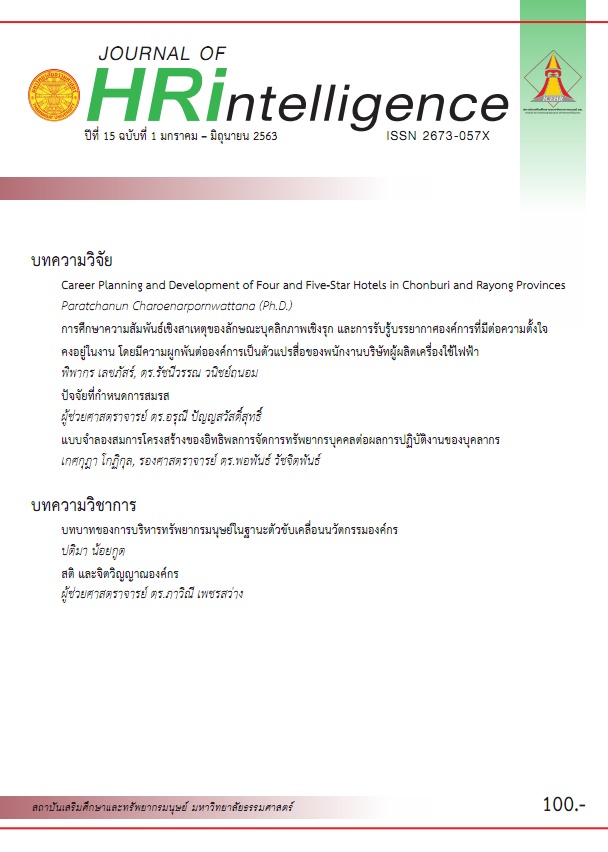Determinants of Marriage
Main Article Content
Abstract
The objective of this research is to study the determinants of marriage of Thai population, male and female separately. The study employs panel data of 77 provinces during 2013–2016. The factors that are hypothesized to affect the marriage rates are categorized as follows: (1) demographic factor, i.e., sex ratio; (2) individual economic status, i.e., wage and education; (3) socioeconomic factors, i.e., relative unemployment rate of male to female and poverty incidence; and (4) health factors, i.e., mental health, which is measured by percentages of depressive disorder patients, physical health, which is approximated by percentages of disables, and patients suffering from metabolic syndrome. The results of Hausman test indicate that random effect models are more appropriated for the estimation. The estimation results show that male wage rate, male education, relative unemployment rate, percentages of depressive disorder patients, and regional dummy variables affect male marriage rate. The North and Northeast regions male marriage rates are higher than Central region. The directions of effects of all independent variables, except depressive disorder patient factor, are as hypothesized. In case of the depressive disorder patient factor, the complete data are not available. In case of the determinants of female marriage rate, it is found that sex ratio, relative unemployment rate, percentages of depressive disorder patients, and regional dummy variables affect female marriage rate. The North and Northeast regions female marriage rates are higher than Central region. The directions of their effects, except those of depressive disorder patient factor, are as hypothesized.
Article Details
ขอมอบลิขสิทธิ์บทความที่ได้รับการตีพิมพ์ให้แก่สถาบันเสริมศึกษาและทรัพยากรมนุษย์ กรณีมีการฟ้องร้องเรื่องการละเมิดลิขสิทธิ์เกี่ยวกับภาพ กราฟ ข้อความส่วนใดส่วนหนึ่ง และ/หรือข้อคิดเห็นที่ปรากฎในบทความ ให้เป็นความรับผิดชอบของข้าพเจ้าและผู้เขียนร่วมแต่เพียงผู้เดียว
References
Becker, G. S. (1973). A Theory of Marriage: Part I. Journal of Political Economy, 81(4), 813–846.
Becker, G. S. (1974). A Theory of Marriage: Part II. Journal of Political Economy, 82(2, Part 2), S11–S26.
Burgess, S., Propper, C. & Aassve, A. (2003). The Role of Income in Marriage and Divorce Transitions among Young Americans. Journal of Population Economics, 16(3), 455–475.
Chansarn, S. (2016). Socioeconomic Determinants of Divorce of Thai People: An Empirical Study in Provincial Level. In Chiang Mai University (Ed.), Proceedings of the 10th National Conference of Economists. Chiang Mai: Chiang Mai University.
Chiappori, P. A., Oreffice, S., & Quintana-Domeque, C. (2012). Fatter Attraction: Anthropometric and Socioeconomic Matching on the Marriage Market. Journal of Political Economy, 120(4), 659-695.
Chuanwan, S. & Katewongsa, P. (2014). Why Women Are Not Married: Where Have Men Gone Missing? In Y. Vorasiriamorn (Ed.), Proceedings of the 10th National Conference on Population and Society 2014. Birth and Security in Population and Society (pp. 23-42). Bangkok: Institute for Population and Social Research Mahidol University.
Coughlin, T. P. & Drewianka, S.D. (2011). Can Rising Inequality Explain Aggregate Trends in Marriage? Evidence from US States, 1977–2005. The B.E. Journal of Economic Analysis & Policy, 11(1), article 3.
Department of Provincial Administration. (2019). Statistics of Marriage Registration. Retrieved from https://stat.bora.dopa.go.th
Gould, E. D. & Paserman, M.D. (2003). Waiting for Mr. Right: Rising Inequality and Declining Marriage Rates. Journal of Urban Economics, 53(2), 257–281.
Grossbard, A. (1984). A Theory of Allocation of Time in Markets for Labour and Marriage. The Economic Journal, 94(376), 863–882.
Grossbard, S. (1993). On the Economics of Marriage: A Theory of Marriage, Labor, and Divorce. Boulder: Westview Press.
Grossbard, S. (2015). The Marriage Motive: A Price Theory of Marriage. How Marriage Markets Affect Employment, Consumption and Savings. New York: Springer–Verlag.
Hausman, J. A. (1978). Specification Tests in Econometrics. Econometrica: Journal of the Econometric Society, 1251-1271.
National Statistical Office Thailand. (2018). The Population and Housing Census. Retrieved from https://portal.nso.go.th/
OECD. (2019). OECD Family Database. Retrieved from https://www.oecd.org
Podhisita C., Varangrat, A., Gray, R., Vapattanawong, P. & Chuanvan, S. (2009). Nuptiality Change in Thailand, 1960 - 2000 :Implication for Future Fertility. Songklanakarin : E-Journal of Social Sciences & Humanities, 15(5), 703-722.
Sasaki, S. (2017). Empirical Analysis of the Effects of Increasing Wage Inequalities on Marriage Behaviors in Japan. Journal of the Japanese and International Economies, 46, 27–42.


